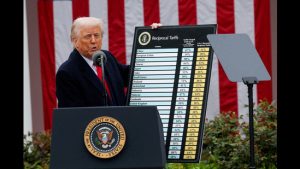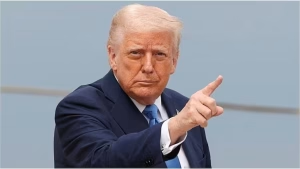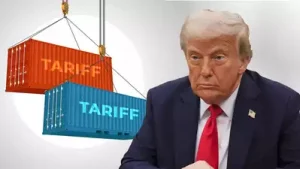Washington – In a significant policy shift that sent shockwaves through global markets and diplomatic circles, US President Donald Trump announced on Wednesday a 90-day pause on his previously declared “reciprocal tariffs” for most nations. The Trump Tariff pause comes as a relief to many trading partners but notably excludes China, against whom the administration has instead escalated duties from 104% to an unprecedented 125%, effective immediately.
The announcement marks a critical juncture in what has rapidly developed into a high-stakes international trade confrontation, with the Trump Tariff policy at its center. Global markets responded dramatically, with US stocks experiencing one of their most substantial single-day gains since World War II immediately following the news.
The Trump Tariff Pause: Strategic Recalibration

President Trump justified the tariff pause in a statement posted to social media, explaining that many nations had initiated diplomatic dialogue rather than retaliation. “Countries around the world have reached out to negotiate rather than retaliate,” the President wrote. “This shows respect for American trade interests, and we’re willing to pause our tariffs while meaningful discussions take place.”
The Trump Tariff pause affects duties that were set to range from 10% to 49% on various nations, providing temporary relief for countries including India, which had been facing a 26% tariff that officially took effect earlier Wednesday. American officials indicated that the pause is conditional on continued good-faith negotiations.
Economic analysts suggest the Trump Tariff strategy may represent a calculated approach to leverage America’s position in global trade. “The Trump Tariff policy has effectively brought trading partners to the negotiation table,” noted Dr. Elizabeth Hartman, Chief Economist at Global Trade Analytics. “By implementing a selective pause while maintaining pressure on China, the administration is applying a carrot-and-stick approach to international trade relations.”
US-China Relations: A New Low as Trump Tariff Rates Soar
The decision to exempt China from the tariff pause and instead increase duties to 125% represents one of the most aggressive economic actions against Beijing in modern history. The Trump Tariff increase against China follows Beijing’s retaliatory measures, which began with a 34% levy against US goods and has now escalated to 84%, set to take effect Thursday.
“China has demonstrated a lack of respect for American economic interests,” President Trump declared in his statement. “While other nations have come to the table, Beijing has chosen escalation over negotiation. The increased Trump Tariff rate reflects our determination to achieve fair trade practices.”
The intensification of the Trump Tariff against China has raised concerns among multinational corporations with supply chains extending into Chinese manufacturing sectors. Businesses are now scrambling to assess the impact on production costs, consumer prices, and potential alternative sourcing options.
“The Trump Tariff escalation against China creates immediate challenges for industries reliant on Chinese components or materials,” explained James Wilson, Director of Supply Chain Management at International Business Consultants. “Companies now face difficult decisions about whether to absorb these costs, pass them to consumers, or restructure their supply chains—none of which can happen overnight.”
Key Takeaways from Trump Tariff Announcement

- Donald Trump announced sweeping reciprocal tariffs on countries across the globe last week, with levies ranging from 10 per cent to 49 per cent. His move rattled global markets and sparked the start of a massive tariff and trade war.
- Trump’s 26 per cent tariff on India came into effect on Wednesday, with authorities in New Delhi assessing the impact of the US levies.
- The trade war between China and the US has triggered fears among people as the two have hit each other with additional and retaliatory tariffs. After Trump’s announcement, China first hit the US with a 34 per cent levy, prompting America to impose a 104 per cent additional tariff on Beijing. This has resulted in China increasing the 34 per cent retaliatory tariff to 84 per cent.
- The European Union has also announced the approval of tariffs to hit around $23.2 billion of US goods in response to the 25 per cent duties on its steel and aluminium exports.
- As China and EU struck US with tariffs, the stock market showed a mixed reaction. However, Donald Trump took to Truth Social and asked them to be calm. He also told Americans that “THIS IS A GREAT TIME TO BUY!”
- Earlier in the day, President Trump claimed that world leaders were “dying to make a deal” with the US and would do anything to secure a pact on tariffs. He said they are saying, “Please, please, sir, make a deal. I’ll do anything sir.”
Global Market Response to the Trump Tariff Announcement
Wall Street responded with extraordinary enthusiasm to the Trump Tariff pause for most nations, despite the continuing tensions with China. The S&P 500 surged 9.5%, while the Dow Jones Industrial Average rocketed nearly 3,000 points higher. The tech-heavy Nasdaq composite jumped an impressive 12.2%, reflecting investor relief that the broader trade war might be contained.
Market analysts attribute the dramatic rally to several factors related to the Trump Tariff policy adjustment:
- Relief that most global trade channels will remain tariff-free during the 90-day pause
- Optimism that negotiations during this period could lead to permanent tariff reductions
- Perception that the administration is pursuing a more targeted approach rather than blanket trade restrictions
- Confidence that the Trump Tariff strategy may ultimately yield more favorable trade terms for the US
“Markets had priced in a worst-case scenario of global tariff escalation,” said Michael Zhang, Senior Market Strategist at Capital Investment Partners. “The Trump Tariff pause represents a more surgical approach focused primarily on China, which investors view as potentially less disruptive to global economic growth than a wholesale trade war.”
Earlier in the day, prior to the announcement, President Trump had claimed that world leaders were “dying to make a deal” with the US and would do anything to secure a pact on tariffs. “They are saying, ‘Please, please, sir, make a deal. I’ll do anything sir,'” the President stated, suggesting the Trump Tariff threat had achieved its intended leverage.
The European Union Response to the Trump Tariff Policy
Despite the general tariff pause, tensions remain with the European Union, which had already announced retaliatory measures before Wednesday’s announcement. The EU has approved tariffs targeting approximately $23.2 billion of US goods in response to the 25% duties previously imposed on European steel and aluminum exports.
It remains unclear whether the Trump Tariff pause will affect these specific steel and aluminum duties, which were separate from the newly announced reciprocal tariffs. European officials have indicated a willingness to engage in negotiations but emphasized that discussions must address all tariff-related issues, including the steel and aluminum duties that preceded this latest round of trade tensions.
“The European Commission welcomes the Trump Tariff pause as a positive step,” said an EU spokesperson in Brussels. “However, comprehensive negotiations must address all outstanding trade issues, including the steel and aluminum tariffs that remain in place and continue to harm European producers.”
Trade experts note that the Trump Tariff strategy with Europe reflects complicated dynamics that extend beyond purely economic considerations into areas of defense spending, NATO contributions, and broader geopolitical alignments.
India’s Position in the Trump Tariff Framework
The 26% Trump Tariff on India technically came into effect on Wednesday before the pause was announced, creating a confusing situation for Indian exporters. Authorities in New Delhi had been assessing the impact of these US levies, with particular concern for India’s key export sectors including pharmaceuticals, textiles, and information technology services.
The Trump Tariff pause has been cautiously welcomed by Indian officials, who indicated that negotiations would focus on addressing the bilateral trade deficit and market access issues. “India values its trade relationship with the United States,” stated a representative from India’s Ministry of Commerce. “We are prepared to engage constructively during this pause in the Trump Tariff implementation to reach a mutually beneficial resolution.”
Analysts note that the Trump Tariff threat has accelerated discussions around a comprehensive trade agreement between the US and India, which had been proceeding at a gradual pace for several years.
Economic Implications of the Trump Tariff Strategy
Economists remain divided on the long-term implications of the Trump Tariff approach. Supporters argue that the strategy is already showing results by bringing reluctant trading partners to the negotiation table, potentially addressing long-standing trade imbalances and unfair practices.
“The Trump Tariff policy represents a recognition that traditional trade negotiations have failed to address structural imbalances,” argued Dr. Robert Carlson, Senior Fellow at the Economic Policy Institute. “By demonstrating willingness to use America’s market leverage, the administration has created urgency among trading partners to address legitimate US concerns.”
Critics, however, caution that the Trump Tariff escalation, particularly with China, risks broader economic consequences that could ultimately harm American consumers and businesses.
“While the Trump Tariff pause for most nations is welcome, the China escalation represents a dangerous gamble,” warned Dr. Sarah Johnson, International Economics Professor at Georgetown University. “These tariffs will inevitably lead to higher prices for American consumers, potential supply chain disruptions, and could trigger further retaliatory measures beyond tariffs, such as regulatory obstacles for US companies operating in China.”
The direct impact of the Trump Tariff on inflation remains a key concern for economic policymakers. The Federal Reserve had previously indicated that significant tariff increases could complicate their inflation-fighting efforts and potentially necessitate maintaining higher interest rates for longer than otherwise planned.
Business Community Response to the Trump Tariff Policy
American business associations have offered mixed reactions to the Trump Tariff developments. While generally relieved by the pause for most nations, industries with significant Chinese supply chain exposure remain deeply concerned about the escalation of duties against Beijing.
“The Trump Tariff pause provides welcome breathing room for many sectors,” said Thomas Richardson, President of the American Trade Association. “However, the China-specific escalation creates serious challenges for manufacturers, retailers, and technology companies with established production relationships in China.”
Businesses are reporting accelerated efforts to diversify supply chains away from China, a trend that began during the previous administration but has gained renewed urgency under the current Trump Tariff framework. Countries like Vietnam, Malaysia, India, and Mexico are seeing increased interest as alternative manufacturing locations.
“The Trump Tariff situation has fundamentally altered risk calculations for supply chain executives,” explained Victoria Chen, Supply Chain Consultant at McKinsey & Company. “Companies that had been gradually diversifying away from China are now treating this as an urgent strategic priority, though the transition involves significant costs and operational challenges.”
Consumer Impact of the Trump Tariff Policy
American consumers may ultimately bear a substantial portion of the cost of the Trump Tariff escalation against China. Retail analysts estimate that the 125% tariff level, if maintained, could result in price increases across numerous consumer categories, from electronics and apparel to household goods and automotive parts.
“The Trump Tariff impact will likely be felt unevenly across consumer segments,” explained consumer economist Dr. James Martinez. “Essential goods with few readily available substitutes may see more significant price increases, while products with more diversified supply chains might experience more modest inflation.”
Retailers are already developing contingency plans in anticipation of potential supply disruptions and price increases resulting from the Trump Tariff situation. These strategies include:
- Accelerating inventory purchases before tariffs fully impact the supply chain
- Seeking alternative suppliers outside China
- Redesigning products to reduce reliance on heavily tariffed components
- Developing pricing strategies that selectively pass costs to consumers
Political Dimensions of the Trump Tariff Strategy
Donald Trump’s tariff strategy was deeply rooted in political considerations, both domestically and globally. Politically, tariffs served as a tool to fulfill campaign promises about protecting American industries, particularly manufacturing and steel. This approach resonated strongly with Trump’s voter base, especially in key swing states like Pennsylvania and Ohio, where job losses due to globalization were a major concern.
Internationally, Trump used tariffs to assert a more aggressive U.S. stance on trade imbalances, particularly with China. His administration argued that prior trade deals disadvantaged the U.S., and tariffs were framed as leverage to force renegotiations. These moves challenged long-standing alliances and shifted the U.S. away from multilateral trade agreements toward more bilateral deals.
Trump also used tariffs as a political message to demonstrate his “America First” doctrine, appealing to nationalist sentiments. The strategy, however, sparked backlash from both domestic industries dependent on imports and international allies, creating political friction. Critics claimed the policy hurt American consumers and farmers through retaliatory tariffs, while supporters praised it as tough economic diplomacy.
In essence, Trump’s tariff policy was not just an economic tool but a political statement, aimed at redefining America’s role in global trade while reinforcing his populist political agenda.
Politically, the Trump Tariff policy represents a fulfillment of campaign promises to prioritize American economic interests in international trade. The administration has framed the approach as necessary to address decades of what it characterizes as unfair trading practices that have disadvantaged American workers.
“The Trump Tariff strategy reflects a fundamental shift in how America approaches international trade,” noted political analyst Maria Rodriguez. “The administration has calculated that the short-term disruption is worth the potential long-term gains in terms of more balanced trade relationships and domestic manufacturing revival.”
Congressional reaction to the Trump Tariff developments has largely followed partisan lines, with Republican lawmakers generally supporting the President’s approach while Democratic representatives have expressed concerns about economic disruption and diplomatic fallout.
Looking Ahead: The Future of the Trump Tariff Framework


As the 90-day Trump Tariff pause proceeds, international attention will focus on several key developments:
- The progress of bilateral negotiations between the US and various trading partners
- The economic impact of the escalated China tariffs on both economies
- Potential further retaliatory measures from Beijing beyond tariffs
- Market stability and investor confidence as the situation evolves
- Effects on global supply chains and production patterns
Trade experts suggest that the Trump Tariff pause creates a critical window for meaningful negotiations, particularly with traditional allies like Europe, Japan, and South Korea.
“The next 90 days will be crucial in determining whether the Trump Tariff strategy ultimately results in more favorable trade arrangements or degenerates into a protracted, mutually destructive trade war,” explained international trade attorney Jennifer Williams. “Success will depend on whether all parties can identify achievable compromises that address core concerns while allowing for political victories on all sides.”
Closing Statements: A Pivotal Moment in Global Trade
The Trump Tariff pause represents a significant inflection point in what had been rapidly escalating global trade tensions. By distinguishing between China and other trading partners, the administration has created space for diplomatic solutions while maintaining pressure on Beijing over longstanding concerns regarding intellectual property, market access, and industrial policies.
The dramatic stock market response suggests investors believe the refined Trump Tariff approach improves the outlook for global economic stability, even as tensions with China reach new heights. However, substantial uncertainties remain about how these complex trade dynamics will ultimately resolve.
As companies, investors, and policymakers navigate this volatile landscape, the Trump Tariff policy continues to reshape global trade patterns and economic relationships in ways that will likely have lasting consequences beyond any temporary pause or escalation. The coming months will reveal whether this approach yields the improved trade deals the administration seeks or leads to more protracted economic conflict with unpredictable consequences for the global economy.

